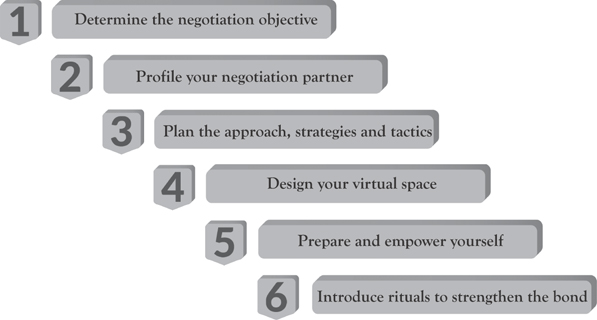CONDUCTING business remotely is the new reality. The COVID-19 crisis has caused a shift in the way business professionals communicate with each other. This chapter will focus on the three most frequent modes of e-negotiations: voice-based (telephone and videoconference) and text-based (instant messaging and e-mail). It is noteworthy that the technical part has not overgone a radical change. Negotiators still follow the traditional framework that encompasses agenda-setting, identification of the objective, preparation of the opening offer, consideration of options and alternatives, demand presentation and exchange, choice of approach, and execution of the negotiation strategy. What has changed is the relational part; consequently, it merits a more detailed analysis. The steps of preparing for a virtual negotiation are presented as follows.

Figure 16.12 Preparation grid for virtual negotiations
The main difference between a normal negotiation and a virtual one is the lack of face-to-face contact between the parties. This makes it more difficult to properly read your negotiation partner, a critical condition for building rapport. In order to better understand the person at the other end of the bandwidth, you will need to dedicate more effort to profiling described in Chapter 8. Some of the person-related barriers in virtual communication include accurate personality assessment and comprehending the mental map of the other person—the mosaic of cultural, environmental, experience-related, and individual elements that drive their behavior. A question often asked is whether we should use humor or emoticons to warm up the atmosphere in e-negotiations. The answer depends on how well you have done the profiling. Humor should be tailored to the human. There is nothing worse than a joke that is met with silence or an emoticon that is out of context or misinterpreted.
Another challenge you need to be aware of are perceptual errors, specifically perceptual selection and the synchrony bias. The former is related to the limitations of the attention span. The brain can only focus on selected pieces of information, so the question you need to ask yourself is how to channel the selective screening of your counterpart to what you want them to focus on. The synchrony bias relates to real-time information exchange (as in the case of phone or video-negotiations), as compared to the asynchrony of e-mail or text message exchange. Not getting a reply to a text message is an equivalent of the silence tactic used in face-to-face negotiations. Silence makes people uneasy and impatient. The main disadvantage of e-silence is that you cannot be sure whether your message was well received or if your counterpart is waiting you out. In order to avoid getting caught up in the vanishing virtual negotiator act, you should agree on a standard response period at the beginning of the negotiation before the tactics roll in.
The concept of synchrony leads to another vital aspect of virtual negotiations—time. In negotiations, timing and place are critical considerations. Have you ever made the right offer at the wrong time? If so, then you know how that ended. You need to use time to your advantage. In international negotiations, you will need to consider geographic time differences that affect business hours and weekend days. Furthermore, certain times of the day, such as before lunchtime, put you at risk of an encounter with a less receptive or distraught, or irritated partner. Furthermore, you will need to understand the individual time preferences of your counterpart—are they night owls or early birds (this will impact their attention spam at certain times of the day), do they have family obligations or individual routines that keep them occupied at certain moments of their day, and so on.
In terms of place, one must not neglect the importance of setting. Virtual negotiations may take place not only in business offices, but also from home offices. While the symbolic of the former is evident, the matter is more delicate when it comes to private settings. Conducting a videoconference from the comfort of your own home will affect your inner power status. Firstly, people tend to be more relaxed and softer in their private environments. This may make them more prone to making concessions. Secondly, what you display in the background is a substitute for the traditional power symbols that function externally.
Notice how experts in videoconferences like to record themselves with shelves filled with volumes of books behind them to imply the expertise power they have acquired. Companies that have their negotiators working from home during lockdowns will instruct them to use the company logo displays as the background. They know that the longer one looks at something, it becomes imprinted in the mind and gains legitimacy. A small investment for a strong persuasion tool. In terms of other tactics, some negotiators will deliberately sit with the light source behind them so that you cannot read their facial expressions clearly. Needless to say, attire and personal grooming also send a strong message about your role and position. Just like an actor in a theater does, design the virtual space to the effect you want to have on your negotiation partner.
Negotiating in virtual reality carries with it the danger of digital miscommunication. The majority of people do not have the ability to decipher the tone of an instant message or an e-mail correctly, although they assess their own skills as high. Some forget the permanent nature of virtual messages and the loss of control over who can read them.
In e-negotiations, alignment between the parties becomes more demanding. The exchanges tend to be more linear, less interactive, and less participative. On the relational level, you will need to create a bond by opening in a positive, action-oriented manner and building rapport before diving into the task. During voice-based negotiations, it is necessary that all parties have an equal opportunity to express themselves. Introduce a pattern of virtual respect and inclusion. When one side monopolizes the discussion, there may be personal resentment, which will increase the risk of precious information falling through the cracks. Remember the 70:30 rule (listen: speak) and gather information on your negotiation partner. Say only what you want to uncover and not more. Never forget that anyone could be listening or registering you, so it is best to be risk-avoidant. In videoconferences, insist that the participants have their cameras on unless you want a more competitive dynamic. It is much easier to attack the little green light on your computer than a person, even if you see that person only on your screen.
Same as in the case of face-to-face negotiations, a virtual one does not end with an agreement being signed. A skilled negotiator needs to ensure the executability of the agreed-on terms. The major challenge is not the task itself, but the creation of the bond between the parties that will allow the task to be implemented. Naturally, rapport is more easily established when we see the person live: we observe the changes in their body language, as well as pick up on the subtle para-verbals. In business, many successfully concluded deals often begin and end with symbolic celebrations, such as a dinner or drinks (or a combination). You will need to adapt that business etiquette to your e-negotiations. Introduce and cultivate small rituals and make them an integral part of the negotiation process. This will differentiate you from all the other virtual personas.
Key takeaways: |
1. Carefully check the accuracy of your profiling results, as you will be lacking face- to-face contact. |
2. Tailor humor to the human. |
3. Agree on a standard response time at the beginning of the negotiation to avoid virtual silence. |
4. Pay attention to the right timing. |
5. Craft your virtual background to your desired effect. |
6. Beware that anything you do in virtual reality leaves a permanent record. |
Chapter 16: Further Reading
Success in e-negotiations requires the grasping of the topic from three angles: the technical aspects related to virtual negotiating, the rules of global business conduct, and solid communication skills. Consequently, to equip yourself with a prep-kit for virtual negotiations, refer to the following:
1. Nicholas Harkiolakis, Daphne Halkias, Sam Abadir, e-Negotiations. Networking and Cross-Cultural Business Transactions
A useful toolkit for remote negotiations with an introduction to technology, online intelligence, and tips for remote dealmaking. I specifically recommend Chapter 6, which deals with communication modes, the advantages and disadvantages of synchronous and asynchronous technologies, as well as main communication mediums for e-negotiations.
![]() Tip for negotiators: Get up to speed on the latest technological advances. Use the tools of modern technology to your advantage in order to succeed in your e-negotiations.
Tip for negotiators: Get up to speed on the latest technological advances. Use the tools of modern technology to your advantage in order to succeed in your e-negotiations.
2. Jeanne M. Brett, Negotiating Globally. How to Negotiate Deals, Resolve Disputes, and Make Decisions Across Cultural Boundaries
A technical framework that will help you and your team better prepare for global negotiations. This book will allow you to understand the intercultural differences and procedural norms that impact negotiations. It presents three strategic models for negotiating in cross-cultural teams.
![]() Tip for negotiators: Remember that the smaller the negotiation team, the more control you have over it. Have proper decision-making procedures in place, clearly designate responsibility lines, and introduce conflict resolution mechanisms to avoid the wisdom of the herd and intercultural pitfalls.
Tip for negotiators: Remember that the smaller the negotiation team, the more control you have over it. Have proper decision-making procedures in place, clearly designate responsibility lines, and introduce conflict resolution mechanisms to avoid the wisdom of the herd and intercultural pitfalls.
3. Alan Barker, Improve Your Communication Skills
A practical guide to enhancing the effectiveness of your virtual business communication skills. It provides tips on how to properly structure e-mails, how to craft presentations by following Monroe’s Motivation Sequence (Page 111), and on how to deliver persuasive messages by appealing to the three elements of character: reason (ethos), logic (logos), and passion (pathos).
![]() Tip for negotiators: Apply the tool of influence RASCAL (reciprocity, authority, scarcity, consistency, alignment, and liking) to enhance your virtual negotiation prowess.
Tip for negotiators: Apply the tool of influence RASCAL (reciprocity, authority, scarcity, consistency, alignment, and liking) to enhance your virtual negotiation prowess.
